La Tolteca 2.0 Issue #8: Teaching, learning & thriving during a Pandemic
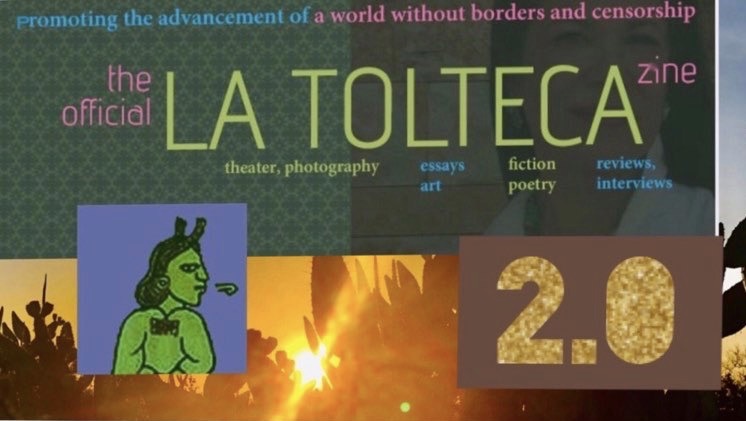
La Tolteca 2.0 October 16. 2020
We are in the 11th hour in these United States regarding presidential elections. The world is experiencing a deadly viral pandemic and everywhere there are natural catastrophes, mostly due to climate change that end displacing communities. Due to COVID-19, teachers, professors and students at all levels have been thrust into a new standard–remote and sometimes isolated classes. A sense of isolation and the many forms it takes are expressed here. In this issue we focus on what these experiences mean to creatives and arts-aficionados who teach.

You don’t have to be a Babe-Boomer or Brown to submit a selfie or fave pic of yourself: ana@anacastillo.net.

Award winning poet, Wendy Barker teaches at University of Texas, San Antonio. See her new poems here.

Aaron Cohen teaches English composition and humanities at the City Colleges of Chicago. His testimonial on collection instruction during COVID testimonial in this issue.

Jane Hseu receives solace from the words of Princess Leia (Carrie Fisher):“Take your broken heart, and make it into art.” See her personal essay on writing about literature and growing up in a home where mental illness is present in this issue.

Carol Gonzales is a writer, educator, and mother. She is a San Antonio native who serves her community by instructing creative writing workshops and cultivating the art of reading and writing in her students throughout the city. See her testimonio here about related challenges. (Photo credit: Steven Treviño)

Nicki de Necochea, her paintings featured in this issue. “Surprisingly, my lifelong love and appreciation for art also flowed onto a canvas. Such fortunate serendipity.”

Brenda Romero came to the U.S. from Mexico to do university studies and stayed. Now a Spanish professor her essay for L/T 2.0 ‘Los Hijos de Zoom” is included here.

Nicki de Necochea: California
Artist Statement: My last name is of Basque origin with ancestors on my father’s side originating from Basque country in Spain in the 1600-1700s, ending up in Argentina and descendants eventually migrating to Mexico. I’ve been told that Neco in the Basque language means”without” and Chea is “house.”

Con la vida no se juega, oil on canvas, 35″ x24″

Listones, oil on campus, 24″ x 35″
I have not studied painting in the sense of how established painters with degrees in fine arts study. I took classes at my local community college under the mentorship of an instructor who had an MFA. I was a late bloomer, having established myself in the business world for most of my adult life. In my late forties and finding myself unemployed, I went back to finish a degree in business. I was missing electives and could take anything I wanted. I chose art–painting and life drawing classes. Surprisingly, my lifelong love and appreciation for art also flowed onto a canvas. Such fortunate serendipity.

Mujer abierta, oil on paper, mixed media on canvas, 24″ X 18″
I paint because of how it makes me feel; I can get lost in it and for me, similar to meditation,. Initially, I was in disbelief of the skills I was developing; initially, painting to learn, and then venturing to paint for family and friends. A few are bequeathed to my sons. It brought me sheer joy to be able to add a touch of my creative soul to my own curated space. Others, I’ve parted with a bit of regret, but it’s a healthy exercise in learning to let go.
It’s been a developmental progression to get to the point of thinking one’s work is at the level of artists who sell. People began to ask. I let the universe guide me through the next steps. In the last few years, I’ve begun to sell my pieces, very much compelled by lack of wall space (lol.) I value exposure to other artists, and the richness of a collective of creatives.

Pareja huichol, Oil and Paper Mixed Media on Canvas 30×30″
I’ve shown in group-arranged small shows; and am fortunate to have sold pieces ranging in price from $500 to $1000. This limits establishing a larger body of work. I believe I need to live to a102 years old to tackle everything in my queue. I am not represented by a gallery, at this time.
We’ve all been so impacted in every aspect of our lives by this pandemic and this unsettling political hate storm we are experiencing. In this time of Covid, I’ve found it more complicated to prioritize art time to paint and create. It’s a challenge in every aspect, physical, emotional, time management, and soul balance. I have full time care responsibility since 2014 when my father passed, for my ninety-one year old mom who has Alzheimer’s and legally blind, (Not so unusual in our culture.) Nonetheless, I’ve made time to paint with a group of pintoras, which I’ve found invaluable, as well as painting on my own while she sleeps. My artist tribe, paints together a few times a month; each with our own styles and project goals. We held monthly artist group critiques to share our works, for input and debate and to discuss art and artists in general. Unfortunately as a result of the pandemic it has been disbanded for now; and a huge loss from a creative and socializing perspective. We share our progress via texts, phones, social media; lifting each other up and encouraging creative progress, in spite of 2020.

Antigua Divided, Oil on Canvas 36″ x 48″ –
I’m a politically not-so-humbly-opinionated liberal, in this very precarious political climate. It only adds to the anxiety, stress, and fear for our democracy. I use my voice in other aspects of my life to express my concerns and political views, but have chosen not to be literal about this in in my art. I’m drawn to painting what reflects pride in my culture and origins. The diversity of my indigenous roots are represented in my paintings. Figurative subjects vary and include Tarahumara, the Huicholes, Mayan, Aztec and mestizo faces and influences.
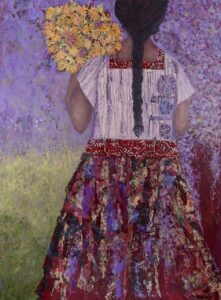
ADELANTE LA NALGONA, OIL-AND-PAPER, MIXED, MEDIA, 36″ X 48″Humble people, humble beginnings; strong, hard working survivors. I experiment with mixed media using papers, pastels along with oils.
In my youth, we were not easily made to feel pride in who we were as a people, even our ancestors and parents sometimes cautioned us not to feel too proud, or be too loud or draw attention – out of survival. I acknowledge that it’s likely why I choose to paint what I do. Gratitude for the gifts found so much later in life than most lifetime artists.

La-Nena (detail) OIL AND PAPERS-MIXED, MEDIA-24X30.
And, gratitude for losing that job leaving me off balance and unemployed that directed me toward discovering that Sí, I can paint!
–Nicki De Necochea
~
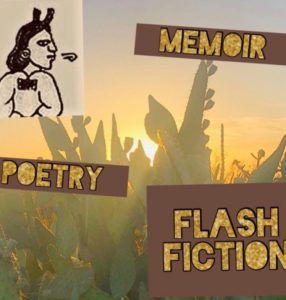
Wendy Barker (Texas)
Four Road Poems
UNDER ROADS
Australia aflame, creatures
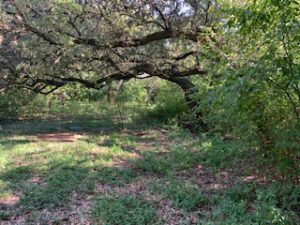
Photo credit: Wendy Barker
in the thousands burning,
but the wombats are saving
wallabies and echidnas, lizards
and skinks, by ushering them
into their burrows, tunnels.
Temps rising here at home.
Last week we hurried through
downtown Austin, at one point
following a woman hunched
over a shopping cart loaded
with ragged clothes, plastic
bags, sackfuls of food. No
burrows tunneled under her.
On our border with Mexico,
thousands crammed behind
scorched barbed wire, kids
yanked from mamás and papás,
hungry, groped, beaten, raped.
Now in my own front yard,
some creature has been digging
a hole, every day wider, deeper.
PANDEMIC ROAD
Upended. Glasses nowhere, couldn’t
see. Sudden kind shoulders to lean on.
Oil slick, they said, not my fault. Then
flashing red lights, the cops, a tow truck.
Car totaled. As Karl Shapiro wrote, an
auto wreck “Cancels our physics with
a sneer.” And now, housebound by
the worst pandemic in a century, cities
thick with thousands retching blood
from a virus that leapt from animals
to humans and from human to human
in a process scientists call “slippery,”
like the road that wrecked my poor car.
I think of Yeats: “All changed,” and
“utterly.” When every rhythm of the day
is erased, when boundaries have circled
so tight we’re starving for human arms
and the open gestures that allow us to
gesture back, we might as well be facing
a wall like the one I crashed into, unable
to see beyond the upended hood of a car
which no longer can take me anywhere
I’d thought I’d always wanted to go.
THESE ROADS
Not a straight and narrow track, but open
sky all day as Steve and I cruised South
Llano River State Park, thickets of live oaks,
mesquite, buckeyes, and juniper, the river
glistening at every turn. No WiFi, no TV,
no bad news blasting. After we parked,
Steve hiked into the river, whose current
dragged him fifty yards downstream
before he could clamber out. But nothing
like the Honduran mamá and her toddler
son who drowned while trying to cross
the Rio Grande. I think of my amigo Miguel,
who, at two, with his familia, fled Durango’s
Sinaloa cartels, the piles of severed heads.
His papá held him, whispering this was only
a game, but then, at the river, the border,
they were locked under flourescent lights till
he felt, he said, like a flattened rat. Sent back,
but years later, enough saved to pay a coyote,
they trudged at night through desert, stars
splattering the sky, then daytimes, hiding
in dark holes. No roads. His red Converse
sneakers turned brown. Finally they crossed
the Rio Grande at Anapra, met by Tía Mela
with her Green Card. Miguel’s shoulders
shook when he told me that story—and after
forty years. But no passports or papers
needed for us today, driver’s licenses, credit
cards tucked in our wallets, water bottles,
lunch packs safe behind the front seat as
we sailed under cerulean skies, feathery clouds.
A galaxy of difference between exploring
and escaping. On our drive to the river and
back, sometimes Steve leaned on the gas till
we soared ten, even twenty miles over the limit,
but we were never once bothered by a cop.
As we headed home, a full moon rose
over the hills, the sunset bleeding behind us.
SABBATH ROAD
Curling through the Catskills,
beeches, oaks, spruce, maples,
pines, leafing, glistening around us.
We hadn’t seen a car, truck, or bus
for miles, when suddenly beside us
on the one-lane dirt road: two dozen
full-bearded, black-hatted men,
women in long skirts, hair hidden
under scarves. As if we’d traveled
back to Eighteenth-Century Belarus
or Galicia. Of course, since this
was Saturday, Shabbos, these Hasidim
couldn’t drive. But where were they
headed? We hadn’t seen a synagogue
anywhere. No one smiled or waved,
and I remembered riding a bus through
Jerusalem’s Mea Shearim, enclave
of Haredim and Hasidim much like
the families close beside us, when I was
glared at, a goyish whore, they must have
been thinking, with my uncovered head,
no loose skirt covering my bare ankles,
and my husband beside me, wearing
no kippah. Men turned their heads
from the front of the bus to glare.
I’ll bet I’d been staring too, never
having seen men with curly sideburns
long as the beards trailing their chests.
But now, at home, a fresh outbreak
of anti-Jewish venom: the Monsey
stabbings, mass shootings in Pittsburgh,
Poway, men and boys chased, punched
in Brooklyn’s Borough Park. Could
be our strolling neighbors are trying
to avoid this savagery against Jews,
even those without wide-brimmed
velvet black toppers. In the car,
as the leaves whispered above,
we tried not to stare at the families
so close to us, knowing that, just as
crowns of trees don’t encroach on
each other’s space, allowing each
tree access to light and air, we
shouldn’t intrude, but still wishing
that, like trees, with underground
networks endlessly messaging,
we could just reach out through
tendrils of our twisted human roots.
Wendy Barker’s seventh collection of poetry:
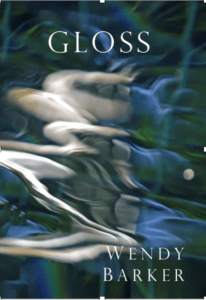
Saint Julian Press, January 2020
Barker’s sixth collection, One Blackbird at a Time received the John Ciardi Prize for Poetry (BkMk Press, 2015).
Aaron Cohen: Chicago

(Testimonial)
Back in February, a student in my Latin American arts & literature course at City Colleges of Chicago seemed anxious. She worked as an assistant nurse at an area hospital and in the middle of a class discussion uttered her warning about a new epidemic that had received some American media coverage. COVID-19 had started its global spread, although, at that time, I had not considered this illness a potential plague. From her job, she had heard far more disturbing news about its imminent local impact. As we all learned a few weeks later, she was not wrong.
My classes moved online shortly afterward. This semester, I still teach only through Zoom and while I had the summer to plan for this situation, that preparation does not compensate for the challenges ahead within my virtual classrooms. When I teach humanities classes, I try to engage students with the larger community around them: This had included requiring them to report on concerts and exhibitions in Chicago. Hearing and reading their responses to a world of music and art that they could access for free within this city has been part of why I believe my teaching has contributed to their lives. These events have all been either cancelled or still too unsafe to attend, but we have enjoyed some streamed performances. I am also grateful for the artists and writers who have Zoomed in to my class as guest speakers.
 “That we still have books to read, enjoy and discuss attests to the enduring need for literature.”
“That we still have books to read, enjoy and discuss attests to the enduring need for literature.”
As much as the students have seen the local arts scenes shattered as a result of the pandemic, so has the living community that I try to develop with in-person classrooms. We no longer share a physical space, we communicate across laptop and phone screens that, one hopes, illuminate in more ways than one whenever somebody speaks. But while the method of delivery has changed, the mutual understanding and sympathy that have always been a part of teaching has become acute in days like these. Many of my students at an urban community college have dealt with inequities and pain even before COVID-19. Some of my students were refugees, others had to negotiate gang territories to come to class. The pandemic has been daunting, but many of my students have already become all too accustomed to obstacles that I had never experienced myself.
After close to a year of this pandemic, I have no idea what the prospects for education in any capacity may be. Most likely, nobody knows. With this focus on my own online classrooms, I do not frequently look around and think about what the economic prospects are for either of my professions, teaching or writing. But when I do read media reports about the pandemic’s impact on higher education, the news is despairing. In this morning’s edition of The Guardian, Lauren Aratani’s article poses a question in its headline: “‘Zoom University’: is college worth the cost without the in-person experience?” (https://www.theguardian.com/world/2020/oct/06/zoom-university-college-cost-students-in-person-experience). After looking at the data, accounting for the numbers of layoffs, firings and furloughs, the answer remains ambiguous. My only certainty is to be present and attentive for my students even if we may never share the same room.
Back in March I let my student who was working in a hospital be excused from class whenever she needed rest. There was no need for her to detail her 12-hour workdays, they were all over the news. She still turned in her papers and got full credit. Everyday heroes are all around us.
~
Aaron Cohen is the author of Move On Up: Chicago Soul Music and Black Cultural Power (University of Chicago Press) and Aretha Franklin’s Amazing Grace (Bloomsbury).
Carol Gonzales: San Antonio, Texas
Remembering the Drumming (testimonio)
Their names mean Beloved. God.
They sit in front of me
apart from each other but still together
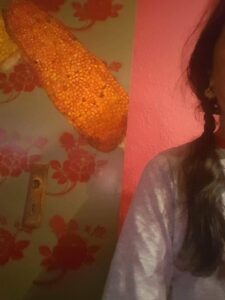
One of the boys is wearing an oversized Navy blue puffer jacket, it had fallen off his shoulders and rested at the bend of his elbows. One sleeve is over his hand and he’s covering his mouth. The other boy, chewed-up fingernails is wearing a worn beanie and sweater in the dead of a very warm Texas Spring afternoon.
I’d brought a book upstairs to show that I had found in the school’s book room and thought they might like. It was called The Drummers. It was simply written and with beautiful illustrations. It was a story about a young boy witnessing a ceremonial drumming circle.
I thought they might like imitating the drumming with me and making some noise.The men in the images of the book were moreno, similar skin color to the young boys—beautiful.

(Shutterstock)
We always looked at a few illustrations before we began reading, so as to make connections and talk about what might look familiar or what was new. The background of every page was all white. The color and vibration belonging only to the men painted in the foreground. One of the men in the book stuck out, he wore a feather headband. I asked who they thought he might be. They hesitated and one of them said, “Maybe the chief?… Maybe?”
“Yes, I agreed, “Perhaps someone important.”
We started to read the book.
Thud.
Thud.
Thud.
“Wey ya heyyy ya, hey ya ho”
I asked them to read it aloud with me.
They did, as they struck the table with their hands. We read the words aloud and drummed on the table altogether, all the boys, smiling and ‘drumming.’ We kept going. They thought out the words of the story, dragging out the different sounds each one contained.
Then, one of them noticed the image of the young boy on the last page, wearing long braids. He started to make fun of the illustration. The other boy joined in.
“Only girls wear braids.” He said.
“Yeah”, said another, giggling.
I asked them if that was true.,Hadn’t they ever seen a boy or an adult man with braids? Corn rows? ¿Trenzas?
They both laughed and said no, even though I knew they must have. I had seen young boys with their hair like this walking in the same hallways. I was stunned. And in disbelief at how they mocked the boys’ braids. These two very young men sitting in front of me could be from a lineage of kings. Not of any fault of their own or their parents–what did they know of their bloodline?
They live in a system that has failed them. Over and over again. A safety net in the education system catching them, only so that the institution that was supposed to hold them up could catch itself. I felt myself grow quiet as the images were already flooding in of the boys.
In past Lives.
Standing tall before a People who looked to them for answers.
And yet here they sat. Forgetting. Or in fact, having been coaxed into forgetting. Tears wanted to come but I held them back.I managed to quiet my mind, moving past the braids and focusing again on the drums and asking comprehension questions. I thanked the boys for reading with me and walked them back to class.
I slid my book bag off the table and walked back to the office, my head bowed. I was furious at everything that was put into a heavily orchestrated scheme in order for young boys that looked like them to fail.
Their names mean Beloved. God. And they are.
I curse the cowards who are still afraid of their energy, even with generations past.
I petition for divine healing over them.
I sing praise over them.
The drums beat for them.
Their ancestors are still reaching out to them–
through this testimony that turns to prayer
and reverberations of the drumming.
May they feel them again so intensely as though they had never forgotten.
~
Carol Gonzales’ work has been published by the San Antonio Art Museum and in various literary journals, including print-zine St. Sucia. When she’s not reading about how to better reach her son and students, she states that she is probably grooving to music with her baby-boy.

Jane Hseu: Chicago
Writing, Literature, and Recovery (Essay)
“…doing the internal work, the writing as expression, the reflection is hard, and requires support and community…”

~
Brenda Romero (California)
¡Viva México, hijos del Zoom! (Memoir) 
En mi natal México, septiembre es el mes patrio. Mis recuerdos de la niñez evocan festivales escolares, la feria local, fuegos artificiales, atuendos tradicionales, y un sinfín de celebraciones para conmemorar la Independencia. Como Octavio Paz expone en su renombrada obra El laberinto de la soledad, es un periodo en que los mexicanos de distintas razas, clases sociales, e ideologías políticas hacen a un lado sus diferencias para unirse bajo el grito popular de ¡Viva México, hijos de la …!
Emigrar a los Estados Unidos significó para mí perder esa experiencia en comunidad. Mis andanzas en el norte comenzaron en Utah, donde además de ver nieve por primera vez aprendí que los mexicanos estamos en todos lados, aunque se trate de una tierra dominada por las enseñanzas de Joseph Smith sin cabida para el culto a la Virgen de Guadalupe. Cada septiembre, cuando muchos en esa región montañosa esperaban con ansias la temporada de los deportes invernales como el esquí, yo recordaba con nostalgia las grandes fiestas patrias de mi infancia. Pequeñas reuniones familiares o la trasmisión televisiva de la celebración en el Zócalo capitalino mexicano sustituyeron los grandiosos festejos durante esos años. Después de todo, tenía otras cosas que celebrar: había aprendido inglés, obtenido la residencia norteamericana, y era la primera en mi familia en asistir a la universidad en este país. La educación se convirtió en mi mayor afán y logré continuar mis estudios hasta obtener un doctorado. ¡Quién lo hubiera imaginado!
Mis elegantes diplomas me llevaron a trabajar como profesora en Nebraska, un estado donde muchos de mis compatriotas trabajan arduamente en las empacadoras de carne. El mes patrio llegó y un sentimiento festivo inundó el ambiente. Sin embargo, la algarabía se debía al inicio de la temporada del fútbol americano colegial; el entretenimiento por excelencia en esos lares.
Siete años después, conseguí el trabajo de mis sueños. Se trataba de un puesto como profesora en una universidad pública en California dedicada a la enseñanza y con un gran número de estudiantes de origen hispano. Septiembre será otra vez maravilloso -pensé. Estaba equivocada. La pandemia del Covid-19 comenzó meses antes de mudarme a Sacramento y cualquier posibilidad de celebrar la Independencia mexicana en comunidad desapareció por completo. Pasaría mi primer mes patrio en California existiendo a través de una pantalla. Ya habrá tiempos mejores. ¡Viva México, hijos del Zoom!
~

Dr. Brenda Romero is an Assistant Professor of Spanish at the Department of World Languages and Literatures at Sacramento State University.
~
GUIDELINES:
Except for La Tolteca 2.0 images all contributing images of art and photos are previously unpublished and credited.
LA TOLTECA 2.0 had made its return here at www.anacastillo.net It is a virtual zine with ongoing posts.
You may submit to ana@anacastillo.net
You’ll receive an automated response. (If you don’t receive the automated response alert me on FB messenger) For consideration to the following new features only unpublished, never posted on SM, original images and material.
New L/T 2.0 Features
BOX 4B: Brown & Beautiful Babe-Boomers
You don’t have to be brown or a Boomer and your submissions don’t have to be selfies to submit. Send us what gave you a smile, lifted your spirits, kept you going that past week. Smart phone pics work, no specific format necessary. Do NOT send images previously posted on social media or elsewhere. Your submission is consent for use at L/T 2.0. Add a couple of lines with your name and about the pic or yourself to be included, if selected. If any of your submission is selected it will be posted the following Friday. If not, you won’t hear from us but you will be welcome to send something new for consideration again.
Yo ¡Presente!
No rants or editorials, please. Only clean, proof-read submissions in a journalistic style will be read for consideration. Double space, 12 point, Times Roman—750 words. Your most recent activist concern. Include your name and a line describing how you participate in social justice issues. Checklist for your piece: What, when, why who and how.
Poetry. Flash Fiction, Memoir and Testimonio
Original and unpublished work. Spanish and English languages considered.
All submissions must have been proofread double-spaced, 12 point, paginated. Fiction word count limit 750. Your name and one line about yourself or your submission.
La Tolteca 2.0 is a blog. We reserve all rights to post as and what we choose.
If your original works appear here you may use again elsewhere with credit to first appearing at La Tolteca 2.0 (and date.)
Thank you for reading, feel free to share link and all positive vibe comments welcome. Issue #9: Day of the Dead Altars will be published here on October 30, 2020 with more fabulous creatives, thrivers and survivors. We welcome original uposted pics of your altars. Submit to: ana@anacastillo.net. You don’t have to be brown and a babe boomer to submit but if you are, we are here for you.

6 Comments
grace purpura October 17, 2020 - 23:26
Enjoyed fully this new issue of La Tolteca! Thank you Ana Castillo and all the new contributors. It was interesting and moving to hear your voices and to get your take on these times of the pandemic when we are turned inward. Lovely illustrations accompany the essays. I love the portrait of the young child by Nicki De Necochea and the poems by Wendy Barker. Writing about mental illness from personal experience is not easy and it took a lot of courage for Jane Hseu to share her story with us. It is not often that we get to read the personal and painful experiences that make the creative people who transcend them.
Jane Hseu October 27, 2020 - 16:54 – In reply to: grace purpura
Grace, thanks so much for your kind and thoughtful comment! Thank you for reading and viewing all of our work! I agree that the issue is fantastic! Regards, Jane Hseu
Ana Castillo October 28, 2020 - 18:37 – In reply to: Jane Hseu
Hello Jane–It’s great to have you in L/T 2.0!
Jane Hseu October 29, 2020 - 13:45 – In reply to: Ana Castillo
Definitely, Ana. Thank you for having me :).
grace purpura January 20, 2021 - 01:04 – In reply to: Jane Hseu
Thank you Jane. Hope this year will renew all our spirits and bring forth dynamic new dimensions in our being. You have great courage and I am glad you have a supportive writing group that sustains you. Suffering affirms your humanity. One thing I have learned is that no matter how dark the clouds seem in your darkest hour, know that the sun is always there behind them.
Ana Castillo January 23, 2021 - 18:39 – In reply to: grace purpura
Thank you. Lamentably, the deaths kept coming and do. But we move forward with unrelenting hope for the future, for the sake of humanity and the planet. Stay well.